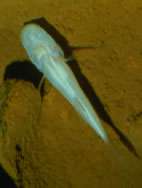Alabama cavefish
| Alabama cavefish | |
|---|---|
 | |
| Scientific classification | |
| Kingdom: | Animalia |
| Phylum: | Chordata |
| Class: | Actinopterygii |
| Order: | Percopsiformes |
| Family: | Amblyopsidae |
| Genus: | Speoplatyrhinus J. E. Cooper & Kuehne, 1974 |
| Species: | S. poulsoni |
| Binomial name | |
| Speoplatyrhinus poulsoni J. E. Cooper & Kuehne, 1974 | |
The Alabama cavefish,[2] Speoplatyrhinus poulsoni, is a critically endangered cavefish found in underground pools in Key Cave, located in northwestern Alabama, United States in the Key Cave National Wildlife Refuge. This is the only known location of the fish, and it was discovered underneath a colony of gray bats in 1974 by Cooper and Kuehne.[3]
Only 9 specimens of the cavefish have been observed, and scientists estimate fewer than 100 are left. This fish is believed to be the rarest of North American cavefish and one of the rarest of all freshwater fish. It is the most specialized cavefish known, and exists in a fragile ecosystem based on nutrient-rich guano of the gray bat. Researchers have failed to find the fish in any other location.
Habitat and distribution
The Alabama cavefish is one of the rarest troglobitic fish species in North America. This species was discovered in 1967 by researcher John E. Cooper, and several specimens were observed over subsequent years. It was so unusual that he created a new genus for its description. The species is restricted to Key Cave in Lauderdale County, Alabama, with only 9 specimens having been collected. Because the underground water system in the area is so widespread, it was hoped that the cavefish had dispersed to other sites. However, studies of 120 other caves in the area, conducted since 1977, have failed to locate any other cavefish populations. The number of individuals in the Key Cave population is estimated to be less than 100. In 1988, the Alabama cavefish was reclassified from "threatened" to "endangered". Two reports of these fish in nearby Collier Cave are unconfirmed. Both caves are protected and inaccessible to the public.
Its longevity ranges from five to 10 years, but it reproduces slower than all other cave-dwellers. Because its known range is limited to a single cave, the Alabama cavefish has an uncertain future, being threatened by changes in groundwater quality and level, changes in aquifer characteristics, and diminished organic input. It also may compete with the syntopic southern cavefish, Typhlichthys subterraneus.
Physiology
The average Alabama cavefish is about 3 in (7.6 cm) long and has no eyes or discernible pigmentation, appearing semitransparent with a slight blue hue. Its large head makes up more than one-third of its length. It is the only species in its genus, and can be distinguished from other cavefish with its very elongated, flattened head with a laterally constricted snout and a terminal mouth. The cavefish lacks pelvic fins, and its fin rays are unbranched with the fin membranes deeply incised between the rays. It has an elaborate system of sensory papillae, arranged in ridges on the head and sides, an adaptation to the dark environment.[4]
Diet
Its diet of copepods, isopods, amphipods, and other fish is supported by the nutrient-filled bat guano.[4] It can also survive on other small organisms such as mites, spiders, millipedes, and beetles and other insects.[5]
Reproduction
It may reproduce like northern cavefish, by carrying its young inside its mouth to be incubated.[5] Since its reproductive cycle appears to be based on various environmental triggers, it does not reproduce every year. Its reproduction could be caused by seasonal flooding in the cave, which causes hormonal changes in the species.[4]
References
- ↑ NatureServe (2012). "Speoplatyrhinus poulsoni". IUCN Red List of Threatened Species. Version 2013.2. International Union for Conservation of Nature. Retrieved 20 January 2004. Listed as Critically Endangered (CR B1ab(iii)+2ab(iii) v3.1)
- ↑ "Speoplatyrhinus poulsoni". Integrated Taxonomic Information System. Retrieved 18 April 2006.
- ↑ Froese, Rainer and Pauly, Daniel, eds. (2006). "Speoplatyrhinus poulsoni" in FishBase. March 2006 version.
- 1 2 3 "Alabama Cavefish". U.S. Fish and Wildlife Service. Archived from the original on 7 October 2014. Retrieved 12 October 2011.
- 1 2 "Alabama Cavefish". Outdoor Alabama. 2008. Archived from the original on 16 March 2009. Retrieved 9 March 2009.
